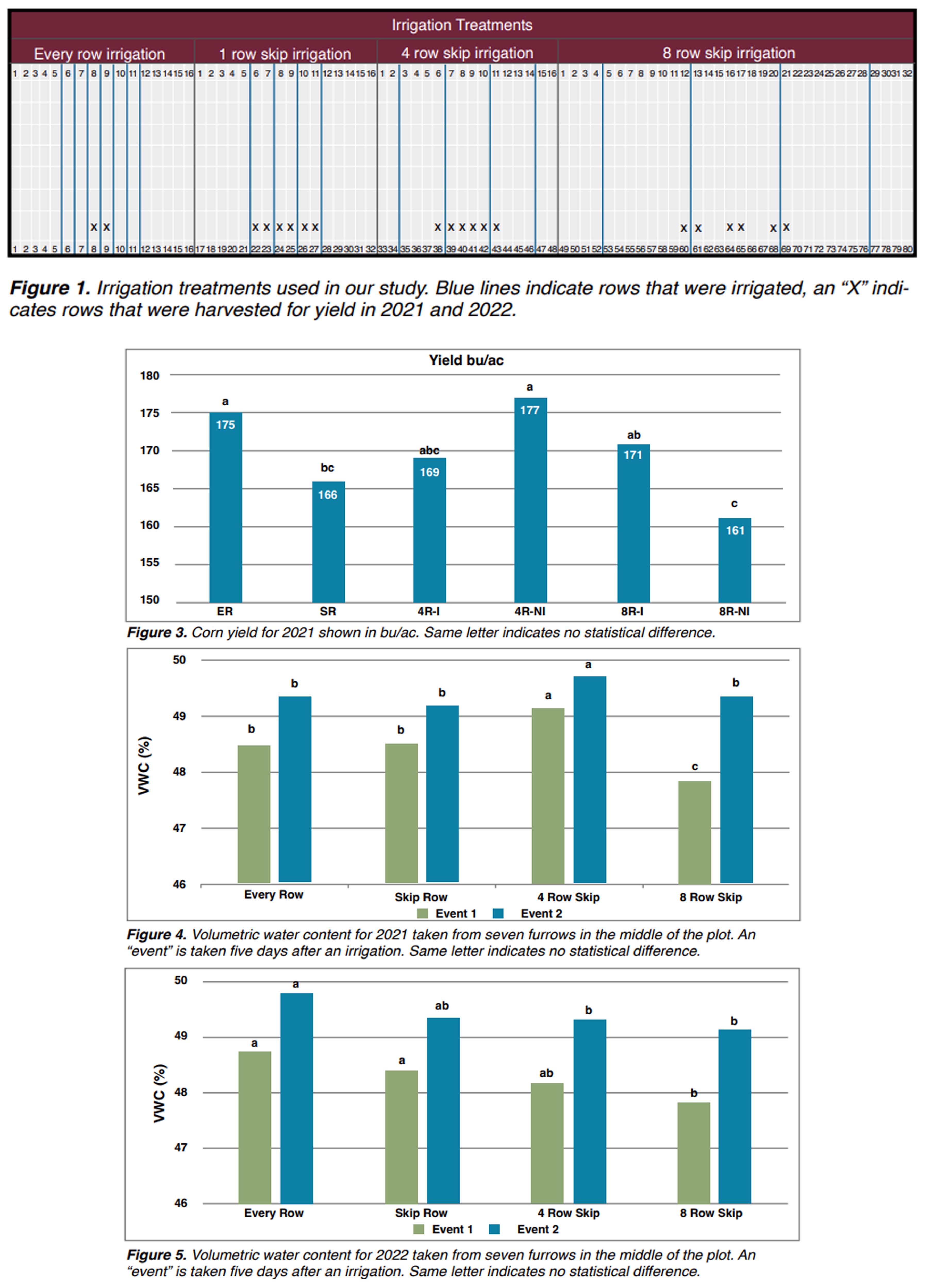Research Project
Furrow Irrigation Spacing Impacts on Corn Production in Sharkey Clay Soils
Investigators: Trey Freeland, Drew Gholson, Gurbir Singh, and Himmy Lo
Date: 2022
Project Summary
Introduction
The Sharkey clay soil series, comprised mainly of 2:1 clay, is the dominant soil mapped in Mississippi, consisting of about 400 thousand hectares (Pettry, et al., 1996). More than 40% of the land is classified under clay soils in the Mississippi Delta. Clayey soils are prone to frequent flooding and waterlogging. Kaur, et al., 2020 reported that corn loses between 5-30% of yield with each day of waterlogging. Every row and one row skip irrigation spacing practiced by Mississippi growers often results in saturated conditions which can lead to lower corn yield. Therefore, the objective of this research was to evaluate if altering irrigation spacings on Sharkey clay soils can reduce the waterlogging damage to corn and subsequently provide a benefit in corn yield.
Materials and Methods
An on-station field experiment was conducted at the National Center for Alluvial Aquifer Research (NCAAR), Stoneville, MS (33°25'26"N, 90°54'54"W) in 2021. All treatments were established in a randomized complete design with four replications. Irrigation treatments included in this study were every row irrigation (ER), 1 row skip irrigation (1R; 80-inch spacing), 4 rows skip irrigation (4R-I; 160-inch spacing), and 8 rows skip irrigation (8R-I; 320-inch spacing) (Figure 1). For treatments 4- and 8- rows skip, yield data was collected from irrigated furrows designated as 4R-I and 8R-I (I, irrigated) and from rows furthest away from the irrigated furrows designated as 4R-NI and 8R-NI (NI, non irrigated). Corn hybrid DKC66-75 was planted at a seeding rate of 42,000 seeds/ac on April 7th, 2021, and 34,400 seeds/ac on May 9th, 2022 at 40 inch row spacing. Urea ammonium nitrate (32%) was applied at a rate of 244 lb/ac as a split application. Weeds were managed using a pre-emergence spray of Lexar @ 96 oz/ac plus paraquat @ 48 oz/ac plus 0.25% scanner in 15 gal/ac tank mix. Halex GT @ 3pt/ac plus round-up powermax 3 @ 48 oz/ac plus 0.25% scanner was used for post-emergence weed management. Volumetric water content (VWC) was taken using a FieldScout TDR 350 Soil Moisture Meter (Aurora, IL) at a depth of 0-20 cm (Figure 2). Data was taken from every furrow before irrigation (event 1), after first irrigation (event 2), and after the second irrigation (event 3). Corn was harvested on August 28th, 2021 and September 9th, 2022, using a Kincaid 8XP plot combine equipped with a harvest master H2 grain gauge.
Results and Discussion
In 2021, the 4R-NI treatment yielded the highest in the trial at 177 bu/ac (Figure 3). The ER treatment had the second highest yield with 175 bu/ac (Figure 3), while the 8R-NI had the lowest yield at 161 bu/ac (Figure 3). In 2022, the trial was heavily diseased which lead to yield being to low to consider for statistical analysis. When looking at VWC% in 2021, the 4 - Row Skip treatments held the highest VWC% in both event 1 and 3. In event 1 the 8 Row Skip was the lowest (Figure 4). This shows that this irrigation treatment had sufficient subsurface lateral movement and that water moved efficiently through the plot for crop water demands without over saturating the soil in 2021. The VWC% data for 2022 shows that in event 1 Every Row and Skip Row treatment held the highest VWC%. In event 2 the Every row was again the highest, while the 8 Row Skip was the lowest in both events (Figure 5). Rainfall may be a significant factor in this study when looking at the amount that fell during the growing seasons. In 2021, 23 in. of rainfall helped to supplement the corn during peak water uptake timings. In 2022, VWC% was less in the 8-row skip compared to the Every Row for both irrigation events. For 2022, yield was low across all treatments and spacing due to disease issues and was not analyzed. Fifteen inches of rainfall fell during peak water uptake timing in 2022, which may also help explain why VWC% were different from the previous year.
Conclusions
In 2021, the result show that a 4 Row Skip Irrigation would be ideal for growers, while accounting for risks that are associated with over saturating the soil or soil waterlogging causing losses in corn grain yields with the Every Row or Skip Row irrigations. The 2022 results show that any irrigation can be used and still hold consistent yield across the board. This research will continue this year, 2023, to see how yield and VWC% correlate to either a wet or dry growing season.
References
Pettry, D. E., & Switzer, R. R. (1996). Sharkey soils in Mississippi - Bulletin 1057, , Division of Agriculture, Forestry, and Veterinary Medicine, Mississippi State University, MS State, MS. https://www.mafes.msstate.edu/ publications/bulletins/b1057.pdf (last accessed: October 5, 2021)
Kaur, G., Singh, G., Motavalli, P. P., Nelson, K. A., Orlowski, J. M., & Golden, B. R. (2020). Impacts and management strategies for crop production in waterlogged or flooded soils: A review. Agronomy Journal, 112(3), 1475-1501.
Project Photos

- Topic:
- Irrigation scheduling
- Irrigation
Find Research
By Crop Type
By Topic
Contact NCAAR
General Information
Kaye Sullivan
vfs23@msstate.edu
662.390.8510
F:662.390.8501
Showcase Demo
Drew Gholson, Coordinator
drew.gholson@msstate.edu
662.390.8505
Himmy Lo
himmy.lo@msstate.edu
662.390.8509

